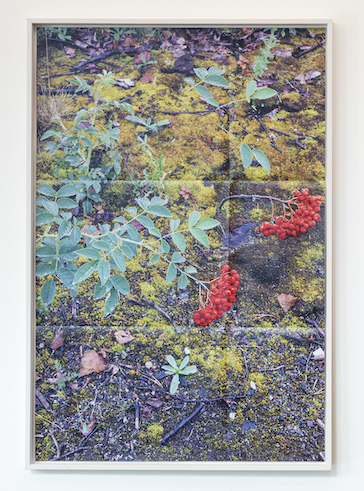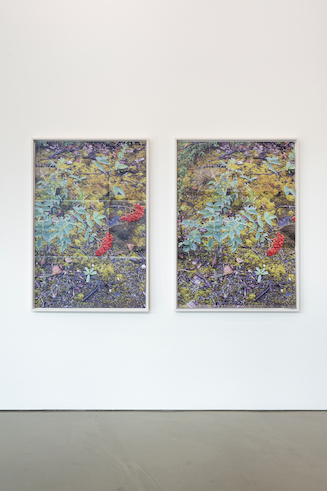Susanne Kriemann
Rowan (Being a Photograph)
Infos
Poster print in vintage frame, 134 × 91 cm; 134 × 96 cm
Edition: variable
Price of single framed work:
€ 400,– (incl. VAT) + postage
Orders:
Angelika Maierhofer
exhibitions@camera-austria.atT. +43 316 81 55 50-16

Description
Brightly standing out on both posters is the rowan plant (Sorbus aucuparia), one of sixty-three listed species in the Monte Schlacko nature reserve, a slag heap on the outskirts of the City of Siegen in North Rhine–Westphalia. Also known as mountain ash, this pioneer tree is found throughout Europe and counts among the rosaceous plants. Its berries, rich in vitamin C and antioxidants, are considered a local superfood and provide nourishment for blackbirds and thrushes, foxes and badgers.
But what if we approached plants by focusing on how their modus vivendi is based on collective living, on sharing and participation? What are the special characteristics of such plant behavior? Since the development of modern botany at the latest, which ranges back to the sixteenth century, philosophers and natural scientists have been studying movements within plants, how their sensitivity varies, and, more recently, the intelligence of vegetation. Susanne Kriemann engages in a research-based artistic practice that explores questions such as these, which are rooted in more-than-human worlds.
This poster edition was created for Camera Austria in the scope of the exhibition Ray, Rock, Rowan (Being a Photograph), as part of a cycle of works called Hey Monte Schlacko, dear Slagorg (2024–ongoing), in which Kriemann explores the abandoned, contaminated, and exploited nature of a slag heap. Monte Schlacko, as a partial nature reserve, has become the home to primary vegetation, including blue-flowering viper’s bugloss, coltsfoot, dandelion, pink-flowering hemp agrimony, alpine strawberry, rowan, mosses, and lichens. Included in the exhibition is a video by Aleksander Komarov that shows sparse ruderal vegetation on toxic and hostile soils in Siegen and in Kharkiv. This vegetation metabolizes the contaminant-permeated soils; the plants respond to their environment, display behavioral traits, and communicate with each other. The question arises: How can we engage in plant-like thinking, with resilience, resistance, and participation, in order to protect our planet from violent encroachment in the future?
Proceeds from the sale of this edition will go to Graz’s art space / studio of Ukrainian artists: ZIEGEL | ЦЕГЛА.


